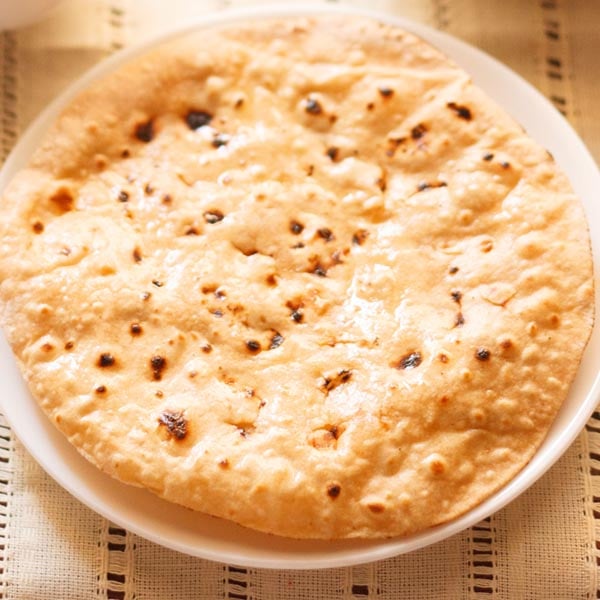Roti Recipe | Chapati Recipe | Phulka Recipe
4.9
(30)
Your folders
Your folders
Prep Time: 10 minutes
Cook Time: 30 minutes
Total: 70 minutes
Servings: 15
Author : Dassana Amit

Ingredients
Export 2 ingredients for grocery delivery
Instructions
Step 1
Take whole wheat flour (atta) in a bowl. Sift the flour with salt if you have flour which has a lot of bran. Add a bit of water, oil or ghee and start mixing.
Step 2
Adding water to the dough in parts, begin to knead the dough.
Step 3
Continue to knead the dough. Keep on adding water as required.
Step 4
Knead the dough till it becomes pliable, smooth and soft. The final dough consistency should not be very sticky or loose or hard.
Step 5
Now make small to medium balls of the dough. Roll the balls in the palms of your hands to smoothen it.
Step 6
Flatten the ball. Sprinkle some whole wheat flour to the dough ball. Alternatively, you can also dust the rolling board with flour.
Step 7
Turn on the gas stove and put the tawa to make it hot.
Step 8
While tawa is getting hot, start rolling the dough ball into a flat round circle.
Step 9
Once the tawa is sufficiently hot then put the roti on a hot tawa/griddle.
Step 10
First cook one side. It should be less than half cooked or about one-fourth cooked.
Step 11
Turn and cook the other side. This should be a little bit more cooked than the first side. Brown spots should be visible.
Step 12
Now hold the roti with a tong and keep the first side which was cooked, directly on fire. The roti will start to puff.
Step 13
Turn and keep the other side on fire. The roti will puff more. Avoid burning the rotis and also don’t overdo it as roti will not be soft and will become crisp and hard like papadums.
Step 14
Remove and apply ghee or oil on the phulka. Applying ghee or oil keep them soft for a long time. Phulka made with this method is ideally served hot.
Step 15
If you cannot serve them hot, then you can keep them in a container that keeps food warm like a casserole or in a roti basket. You can also wrap them up in a kitchen towel or napkin.
Step 16
Place the rolled roti dough on a hot tawa or skillet. Keep the heat to medium-high or high. Within some seconds you will see air pockets forming on the raw chapati dough
Step 17
Roast for about 30 seconds or so and you will see the air-pockets increase on the surface.
Step 18
Keep in mind that the timing will change or vary with the kind of skillet you are using, the chapati thickness and the intensity of the flame.
Step 19
Flip with spatula or tongs and roast the second side for about a minute.
Step 20
Flip again and you will see the second side cooked more than the first side with visible brown spots.
Step 21
With a clean folded cotton kitchen napkin or a spatula, begin to press the partially cooked roti on all sides and center. Pressing it evenly all over helps to puff up the roti.
Step 22
Keep on pressing all over, especially the flat portions, so that the entire roti gets puffed up well.
Step 23
If you prefer you can flip again and cook the second side too for some seconds if its looks under cooked.
Step 24
Transfer the soft and puffed roti in a roti-basket and spread some oil or ghee on top.
Step 25
Keep the rolled roti dough on a hot tawa or skillet. Cook on medium-high to high heat for about 30 seconds or so until you see some air pockets all over.
Step 26
Flip the chapati and spread some oil all over while the second side is getting roasted. Cook the second side for about 45 seconds to 1 minute.
Step 27
Flip again with a spatula. You will see that the second side is well roasted with some blisters and brown spots.
Step 28
Spread some oil on this cooked side. Roast the first side again for about 20 to 30 seconds.
Step 29
Remove and transfer to a chapati container or box. Keep covered. Make chapati with the rest of the dough in this manner.
Step 30
Serve roti or phulka or chapati with any Indian meal. Accompany it with vegetable or paneer curries, stir-fried or sautéed vegetables (sabji) or lentils (dals).
Step 31
Store any leftover dough in an air-tight container for just about 1 to 2 days. If the dough has darkened or has a weird smell, then throw it away.
Step 32
Store the flatbreads in a roti box or in a covered container for a few hours. Always cover with a tight lid, so that the flatbreads remain soft. Brushing or spreading with some oil or ghee on the roti, keeps them softer.